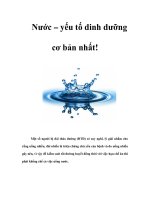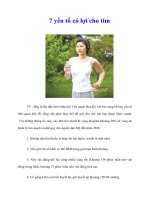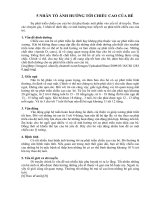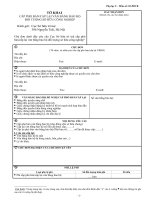Tài liệu Parental Attitude to Children with Sickle Cell Disease in Selected Health Facilities in Irepodun Local Government, Kwara State, Nigeria doc
Bạn đang xem bản rút gọn của tài liệu. Xem và tải ngay bản đầy đủ của tài liệu tại đây (40.02 KB, 8 trang )
INTRODUCTION
Sickle cell disorder (SCD) is one of the
commonest but preventable inherited diseases.
It is a disease that affects the red blood cells and
is a lifelong ailment which has been with man
since the existence of man. Sickle cell affects all
races of the world, it affects the people of tropical
Africa, Mediterranean Sea, Middle East and South
India. It has contributed significantly to the high
childhood mortality rate.
Nigeria has an estimated population of 150
million with annual growth rate of 3.2%. The
current figure of individuals in Nigeria with this
disorder is not known since the majority born in
rural community do not survive childhood and
for lack of proper statistics. However, an estimate
of about 2.3% of the Nigerian population suffer
from sickle cell disorder and about 25% of
Nigerians are healthy carriers of the abnormal
hemoglobin gene.
Anie et al. (2010) were of the view that SCD is
a global health problem with psychosocial
implications and that Nigeria has the largest
population of people with SCD with about 150,000
births annually, although over 300,000 babies are
born worldwide with SCD, mostly in low and
middle income countries with the majority of these
births in Africa.
Sickle cell disease was first found prevalent
in the African American populations in 1910
(Durham 1991). Sickle cell anemia is a type of
sickle cell disease in which there is a single point
mutation on the β-globin gene.
Sickle cell anemia (SCA) and Hemoglobin SC
disease (HbSC) are the two most frequent types
of sickle cell disease (SCD) in Cuba and as both
are hereditary diseases with an autosomal
recessive pattern of inheritance. SCA is caused
by a structural variant of the major adult
hemoglobin called S or Sickle hemoglobin (HbS),
while HbSC is caused by the presence of two
variants, one of them is sickle hemoglobin and
another is hemoglobin C (HbC) this variants result
from HbS and HbC allelic genes in beta globin
locus in chromosome 11p 15.5. HbS allele differs
from the normal allele A, in a single amino acid; at
position 6 a valine replace a glutamic acid residue.
In HbC allele, at the same locus lysine replace
glutamic acid residue also at position 6. Affected
individuals with SCA are homozygous SS,
because they inherit one HbS allele from each
© Kamla-Raj 2011 Ethno Med, 5(1): 33-40 (2011)
Parental Attitude to Children with Sickle Cell Disease in
Selected Health Facilities in Irepodun Local Government,
Kwara State, Nigeria
Joel Adeleke Afolayan
*
and Florence Tayo Jolayemi
**
*Faculty of Nursing, Niger Delta University, Bayelsa State, Nigeria
Telephone: +2348037116208, +2348052625510, E-mail:
**Irepodun Local Government Secretariat, Omu-Aran, Nigeria
KEYWORDS Heredity. Incompatibility. Individual Differences. Pathologic Disease
ABSTRACT The study investigated parental attitude towards children with sickle cell disease in selected health
facilities in Irepodun Local Government, Kwara State, Nigeria. 80 participants were purposively selected for the
study. A self-reporting questionnaire was used to collect the needed information from the parents of children with
sickle cell disease. Simple percentage and Chi-square were used to analyze the data. Findings from the study showed
that about 87% of the participants regretted having such children and gave reasons such as lack of enlightenment
programme on sickle cell anemia, no genetic counseling, ill-disposition to pre-marital genotypic screening, inadequate
medical facilities for adequate test for genotype in rural areas, gross misrepresentation and wrong perception of sickle
cell disease, lack of knowledge of people on sickle cell disease and nonchalant attitude to the result of screening due
to love and interest in one’s partners. It is therefore recommended that adequate mobilization of educative programmes
on importance of pre-marital genetic counseling should be done, facilities should be provided for genotype screening
freely for the members of the society, it should be made compulsory for all intending couples and where incompatibility
exists, they should not be allowed to marry. The government should legislate in this area by not allowing marriages
between non-compatible individuals and should provide free health service for sickle cell patients while their drugs
should be made available in the clinics/hospitals.
JOEL ADELEKE AFOLAYAN AND FLORENCE TAYO JOLAYEMI
parent; while affected individuals with HbSC are
heterozygous SC, because they inherit one HbSC
allele from a parent and one HbC allele from
another one. These genes are quite common
among African ancestry (Ruiz et al. 2007).
In Western and Central Africa where as many
as 1-2% of children have sickle cell anemia or
HbSC disease, sickle cell anemia is a public health
and individual dilemma. Apart from the attendant
high morbidity, sickle cell disease also inflicts
economic psychological and physical strains on
the patients’ parents and their relations. Sickle
cell disease arise from the inheritance of two
abnormal hemoglobin genes one from each parent
i.e. HbS. Hemoglobin is liquid part of the red blood
cells which carries genes.
Genes are responsible for all inherited
characteristics of humans and the main function
of hemoglobin is to carry oxygen and food to
other parts of the body. In Africa, children with
sickle cell disease are usually first diagnosed
following an acute disease and not by screening
hence regrettably, diagnosis are often delayed.
An overwhelming majority of parents having
children with sickle cell disease in Africa live and
die without tests needed to establish the correct
diagnosis. Most infants with sickle cell disease
are unlikely to have been diagnosed before or
even during episodes of acute illness. Most of all
children in rural Africa have no access to modern
healthcare facilities and where traditional system
is practiced, there is no chance that an infant with
sickle cell disease will be diagnosed correctly.
The association of hemoglobin S with cases
of renal medullary carcinoma, early stage of renal
failure in autosomal dominant polycystic kidney
disease and surrogate endpoint for pulmonary
embolism are not necessarily the result of
hemoglobin S polymerization, while buttressing
his argument, he maintained that complications
from sickle cell trait are important because about
three million people in the USA have this
genotype, about 40 to 50 times the number with
sickle cell disease. Nagel and Fleming (1992)
reported that a number of studies have shown
association of sickle cell trait with prematurity
and lower birth weight of babies. They added
that complications attributed by some to sickle
cell trait includes proliferation retinopathy,
worsening of diabetic retinopathy, stroke,
myocardial infection, leg ulcers, vascular necrosis,
arthritis of the joints and increased frequency of
the bends from driving although there is no
convincing evidence that sickle cell trait increases
the incidence of these problems.
Lesi (1982) identified some types of sickle cell
crises as hemolytic crisis, aplastic crisis and vaso-
occlusive crisis and factors contributing to the
crisis are infections caused by Diplococcus
pneumonia, haemophilus, influenza, Escherichia
coli, Salmonella, malaria, exercises, cold weather
etc.
The trauma experienced from sickle cell
disease cannot be over emphasized. Katibi (2008)
stated that patients with sickle cell disease may
have recurrent illness and be hospitalized due to
various complications of the disease. The cost
implication and mental agony of the parents in
particular are of significant note. He further
identified physical deformities of the patients such
as frontal bossing, protruding abdomen, thin
extremities and gnathopathy. Other impacts are:
absenteeism from school due to frequent illness,
difficulty in getting marital partner, damaging
effect of the stigma of being a sickler on his/her
psyche, reduced chances of getting pregnant for
females, fear of frequent illness during pregnancy
(females), increased abortion rate, anxiety on the
possible genotype of the baby in – utero, needs
for ante-natal diagnosis and its attendant risks,
need for therapeutic abortion in case of an
unfavorable genotype attendant risk, persistent
state of anxiety and tension because the
individual can get ill at any time and psychosocial
trauma of the knowledge of imminent death. More
importantly, the victims may be unable to realize/
actualize his dreams in life and there is denial of
some rights and privileges such as work,
freedoms, marriage and sex. Katibi stated further
that cost of daily maintenance of sickle cell patient
is colossal in terms of drugs, nutrition, prevention
of crisis, hospitalization and that the affected
individuals or families suffer a burden of anxiety,
frequent illness, excess mortality rates, ignorance
and lack of appropriate health services and
research.
Family as a social system theory was used as
theoretical basis for the study. According to the
most acceptable and common view, the family has
been defined as a group of persons united by
ties of marriage, blood or adoption constituting a
single household. This shows that family implies
that usually this small kin-group is a single
economic unit, all members share a common
culture and authority may be vested in one or
many persons of the household. Family is
34
PARENTAL ATTITUDE TO CHILDREN WITH SICKLE CELL DISEASE
generally seen as a functional and a socio-cultural
unit of the society. It involves the recognition of
just those who are closely related to oneself
through constant physical continuity, physical
cooperation, emotional bonds and blood ties. The
sex and hunger drives of a man, his economic
compulsions and cultural traditions within which
he is bound have provided theoretical justification
for the recognition of the existence of family. The
birth of off-springs cements and integrates his
family life (NOUN 2004).
Noll et al. (1998) asserted that families who
have children with sickle cell disease (SCD) endure
numerous potentially stressful experiences and
daily hassles related to the biological
complications of SCD. These ordeals can cause
difficulties with finances, work, transportation and
changes to daily routines. Mothers of children
with SCD are at risk for excessive anxiety,
depressed mood, guilt, social isolation and
personal health problems.
Psychosocial issues for people with SCD and
their families mainly result from the impact of pain
and symptoms on their daily lives and society’s
attitudes to SCD and those affected. In Africa,
cultural factors are particularly relevant to these
problems because of beliefs and traditional
practices. In Nigeria, beliefs are usually influenced
by cultural and religious values, which influence
health behaviours such as coping strategies.
Bennett (2007) was of the view that a child
affected by SCD is often a shock for the parents
no matter how well prepared the parents may have
felt. The initial hurdle of accepting the diagnosis
is often quite difficult and parents may experience
the initial emotion of denial. Other common
emotions include anger, fear and even grief.
Sometimes there is an overwhelming sense of
frustration, the blame of self and also of partners
and feelings of inadequacies are not uncommon
but for the majority of parents, these are transient
emotions but others never come to terms with
the fact that their offspring is affected by SCD.
Environmental and social factors are major
influences on the parents’ ability to cope and these
have far reaching implications affecting the child
in all aspects of his or her development. Parents
with little or no support, living in unsuitable
accommodation would perhaps find it more
difficult to cope with an affected child more so
than those parents who are well supported and
are not experiencing hardship (Shepherd and
Stuart 2001; Kiddy and Thurtle 2002).
Whitehead et al. (2010) opined that most of
the crises faced by the parents of children with
SCD could have been prevented or better
managed if their parents had knowledge of
newborn screening but review of the literature
shows that most parents are unaware of newborn
screening unless their infant has had an abnormal
result.
Parents who are aware of the screening are
not knowledgeable about the process of reporting
screening result or the conditions for which
newborns are screened. In fact, many parents also
confuse genetic screening with testing for
jaundice, infections or drug exposure.
Parents are unaware of and unable to consider
the implications of testing which can increase
their distress if the result is abnormal.
In this study, the children with sickle cell
disease are products of the parents’ genes who
are biological members of the fathers and mothers.
Interestingly, his/her present state he/she picked
it from them and whatever he/she becomes is the
handiwork of the parents as family is said to be
the cradle of the future society. When a family
properly understands this especially parents,
they will be able to show a positive and warm
attitude towards their children with sickle cell
disease. Definitely, if the parents show a positive
attitude, other members of the family (siblings)
will not show a negative attitude towards their
kins with sickle cell disease, but would show a
loving, caring and passionate attitude since all
have the same bond.
METHOD
The research design adopted was a
descriptive method to investigate the parental
attitude towards children with sickle cell disease
in selected health facilities in Irepodun Local
Government Area of Kwara State, Nigeria.
Population
All the parents of children confirmed with
diagnosis of sickle cell disease qualified for the
study as participants in Irepodun Local
Government Area of Kwara State.
Sample and Sampling Procedure
80 participants were selected from identified
health facilities in Irepodun Local Government.
35
JOEL ADELEKE AFOLAYAN AND FLORENCE TAYO JOLAYEMI
For better representation, four government and
one private hospitals were chosen for the study.
Four hospitals were either owned by federal, state
and local government authorities and the fifth
one owned by a private individual. The partici-
pants were selected by convenience in the various
hospitals and by volunteerism as: General
Hospital, Oro: 20, General Hospital, Omu-Aran:
20, Comprehensive Health Centre, Esie: 20, Local
Government Health Centre, Ajase-Ipo: 10 and
Adeyemo Private Hospital: 10 (20+20+20+
10+10=80 participants). 65 females and 15 males
were selected for the study with the age range
between 20 and 60 respectively.
Instrumentation
Self-reporting questionnaire was constructed
to gather the required data for the study. The
questionnaire was divided into two units. Unit A
dealt with personal data of the participants while
Unit B was on related questions on sickle cell
disease and attitudes of parents toward their
children with sickle cell disease. Unit A had seven
items while Unit B had 46 items with Yes/No
responses.
The questionnaire was given to senior
researchers in the Faculty of Nursing, Niger Delta
University for their inputs, the corrections and
suggestions were effected which improved the
quality of the instrument to meet the content and
face validity.
A pilot study was conducted on two partici-
pants each from the five selected health facilities
that were used for the final study, the outcome
was collated and where necessary corrections
were made on the items and the test-retest
coefficient was 0.78.
Ethical Consideration
The researchers visited all the selected health
facilities for the study, discussed with the Officers-
in-charge on the aims and objectives of the study,
the procedure and feedback was assured which
would contribute immensely to the management
of their patients and hospitals. At the end of each
meeting with the hospital management, informed
consent was given. Luckily, each hospital runs a
sickle cell disease clinic day which made the
contacts easier for the researchers. The partici-
pants were met on the day of clinics for their
children by the researchers and hospital heads
so that they could be explained to the objectives
of the study, given assurance of confidentiality
of information offered and assurance of feedback
at the end of the study, all these assurances made
the participants give their informed consent with
ease and hence, they volunteered themselves for
the study.
Procedure for Data Collection
On the clinic days of each selected health
facility, the researchers met the participants, re-
explained the purpose of the study and assured
them of confidentiality of privileged information
and a feedback after the study as told to them in
the last meeting. Then the researchers requested
for volunteers in relation to the required number
per health facility. The volunteers were
enthusiastic to be part of the study and they
assured of their maximum cooperation to help the
study and themselves also. The questionnaires
were distributed to them individually, they were
given 40 minutes to complete after which the
instruments were retrieved, various questions
they had were responded to, to the best of
knowledge of the researchers. It was quite an
eventful moment at each study centre.
Hypotheses
Five hypotheses were used for the study,
tested at the significance level of 0.5.
1. There will be no significant relationship
between the sex of the participants and their
attitude towards children with sickle cell
disease.
2. Religion would not make significant
difference in the attitude of parents towards
their children with sickle cell disease.
3. There will be no significant relationship
between knowledge about the cause(s) of
sickle cell disease of the participants and
their attitude towards their children with
sickle cell disease.
4. Knowledge of the impact of sickle cell
disease will not make significant difference
in the attitude of parents with children with
sickle cell disease.
5. There will be no significant relationship
between the knowledge of the participants
on the prevention of sickle cell disease and
their attitude towards children with sickle cell
disease.
36
PARENTAL ATTITUDE TO CHILDREN WITH SICKLE CELL DISEASE
RESULTS
The data were collated and simple percentage
used while Chi-square was used in the testing of
the hypotheses at significant level of 0.5.
Table 1 showed the personal data of the 80
participants as: distribution was 25% were from
General Hospital, Omu-Aran; 25% from General
Hospital, Oro; 25% from Comprehensive Health
Centre, Esie; 12.5% from Local Government Health
Centre and 12.5% from Adeyemo hospital i.e.
private hospital. The age distribution showed that
43.75% were between 35 and 44 years, 25% were
between 25 and 34 years of age, 12.50% were
between 45 and 54 years, 12.50% were above 54
years, and 6.25% were below the age of 25 years.
Gender distribution showed that 81.25% were
females and 18.75% were males.
Distribution of marital status showed that
37.50% were divorced, 25% were widowed, 18.75%
were married, 12.50% were separated and 6.25%
were single (single parents). The age of marriage
distribution showed that 43.75% were between
11 and 15 years, 12.50% below 2 years and 2.5
years respectively and 6.25% were between 16
and 20 years and also above 20 years while the
frequency in hospital showed that 50% come to
hospitals every month, 25% every 3-4 months,
18.75% every 1-2 months and 6.25% 5-6 months.
Hypothesis 1: There will be no significant
relationship between the sex of the participants
and their attitudes towards children with sickle
cell disease.
The calculated value (31.61) was greater than
the table value (12.3) indicating a significant
relationship between the sex of the participants
and their attitude towards children with sickle cell
disease (Table 2).
Hypothesis 2: Religion would not make
significant difference in the attitude of parents
towards their children with sickle cell disease.
The calculated value was 16.62 which was
higher than the table value of 12.3 this showed
that religion had significant difference in the
attitude of parents whose children have sickle
cell disease (Table 3).
Hypothesis 3: There will be no significant
relationship between the participants’ knowledge
about the causes of sickle cell disease and their
attitudes toward children with sickle cell disease.
Table 2: Relationship of sex and attitude of the participants toward children with sickle cell disease
Variable Response
Yes % No % Total
Sex
Male 5 6.25 10 12.50 18.75
Female 60 75.00 5 6.25 81.25
Total 65 81.25 15 18.75 100.00
χ
2
cal = 31.61 χ
2
tab = 12.3, df = 1
= χ
2
(1, N = 80) = 31.61 , P < .05.
Table 1: Personal data of the participants
Variables f %
Name of Hospital
General Hospital, Oro 20 25.0
General Hospital, Omu-Aran 20 25.0
Comprehensive Health Centre, Esie 20 25.0
Local Government Health Centre, 10 12.5
Ajase-Ipo
Adeyemo Hospital (Private), 10 12.5
Omu-Aran
Age
20 -25 years 5 6.25
25- 34 15 18.75
35- 44 30 37.5
44 -54 20 25.0
54-60 10 12.5
Sex
Male 15 18.75
Female 65 81.25
Marital Status
Single 10 12.5
Married 10 12.5
Divorced 35 43.75
Widowed 15 18.75
Separated 5 6.25
Age of Marriage 5 6.25
Below 2 years
2 -5 years 70 85.0
6 – 10 years 4 2.0
11 – 15 years 6 3.0
16 – 20 years 2 1.0
Above 20 years 18 9.0
Frequency in Hospital
Every month 40 50.0
1 – 2 months 15 18.75
3 – 4 months 20 25.0
5 – 6 months 5 6.25
37
JOEL ADELEKE AFOLAYAN AND FLORENCE TAYO JOLAYEMI
The table 4 showed that calculated value of
15.60 higher than table value of 12.3 showing that
there was a significant relationship between
knowledge about the cause(s) of sickle cell
disease and the attitude of parents towards their
children with sickle cell disease.
Hypothesis 4: Knowledge of the impact of
sickle cell disease will not make significant
difference in the attitude of parents with children
with sickle cell disease.
Calculated value of 19.41 was higher that table
value of 12.3 hence knowledge of impact of sickle
cell disease made significant difference in the
attitude of parents with children with sickle cell
disease (Table 5).
Hypothesis 5: There was no significant
relationship between the knowledge of the
participants on the prevention of sickle cell
disease and their attitude towards children with
sickle cell disease.
The table 6 showed that calculated value of
14.44 higher than table value of 12.4 so there was
a significant relationship between knowledge of
the participants as par prevention of sickle cell
disease and attitude towards their children with
sickle cell disease.
Table 3: Summary of
χχ
χχ
χ
2
of the religion of the participants
Variable Response
Yes % No % Total
Participants’ Knowledge
Male 12 15.0 3 3.75 18.75
Female 60 75.0 5 6.25 81.25
Total 72 90.0 90 10.00 100.00
χ
2
cal = 15.60, χ
2
tab = 12.3, df = 1
= χ
2
(1, N = 80) = 15.60, P<.05.
Table 4: Participants’ knowledge about causes of sickle cell disease and attitudes towards children
Variable Response
Yes % No % Total
Participants’ Knowledge
Male 12 15 3 3.75 18.75
Female 60 75 5 6.25 81.25
Total 72 90 90 10 100.00
χ
2
cal = 15.60, χ
2
tab = 12.3, df = 1
= χ
2
(1, N = 80) = 15.60, P<.05.
Table 5: Knowledge of the impact of sickle cell disease and attitudes towards children
Variable Response
Yes % No % Total
Knowledge of the Impact of Sickle Cell Disease
Male 8 10 7 8.75 18.75
Female 55 68.75 10 12.5 81.25
Total 63 78.75 17 11.25 100.00
χ
2
cal = 19.41, χ
2
tab = 12.3, df = 1
= χ
2
(1, N = 80) = 19.41, P<.05.
Table 6: Participants’ knowledge about the prevention of sickle cell disease and attitudes toward children
Variable Response
Yes % No % Total
Knowledge of the Participants on the Prevention of Sickle Cell Disease
Male 15 18.75 0 0 18.75
Female 58 72.5 7 8.75 81.25
Total 73 91.25 7 8.75 100.00
χ
2
cal = 14.44, χ
2
tab = 12.3, df = 1
= χ
2
(1, N = 80) = 14.44, P<.05.
38
PARENTAL ATTITUDE TO CHILDREN WITH SICKLE CELL DISEASE
DISCUSSION
The findings showed that sex correlates with
the attitude of the parents to the children with
sickle cell disease although most of the
participants were females because they interacted
with the health facilities since mostly mothers stay
with their children in the hospitals or accompany
them to the hospitals, most mothers are more
caring than fathers regardless of the diagnoses
of their children even the prognoses. It showed
majority of the respondents ended up with their
marriages in divorce, separation, even death of
spouses which may be due to their attitudes
towards sickle cell disease. Females are better
enduring individuals than males especially in
difficult situations as they will not ignore or
neglect their children even in case of sickle cell
disease that does not have a cure.
Religion was another variable that influenced
the attitude of these parents to their children with
sickle cell disease. With highly religious parents,
their attitudes would be obviously positive as
they would show more of love, care, compassion
and passion in whatever they do for these
children, especially when in crisis, they will also
accept their fate for having such children, see it
as an act of God, as destiny, while the low
religious parents will blame themselves for having
married such a spouse who produced such
children. They might have expression of regret
which their children might see, they feel bored
hence, so may end such marriages in divorce or
separation, leaving the victims with either the
fathers or mothers.
Anie et al. (2010) were of the opinion that
cultural and religious values have significant
impact on the attitudes of parents of children with
sickle cell disease especially in Nigeria as these
variables influence their health behavior in
relation to coping strategies as most parents
submit to their fate.
Knowledge about the causes, impacts and
prevention is crucial to the management of sickle
cell disease. In Nigeria, the majority are illiterate
and poor, subjected to economic exploitation,
deprivation and social ostracism which is reflected
in their low quality of life. These underprivileged
ones in the society face social stigma forcing them
to occupy the lowest rung of the social ladder,
leading to inability to meet the daily demands of
their sickle cell afflicted children. Erinosho (2005)
explained that the general belief among Nigerians
is that illness can be caused by natural, preter-
natural and mystical factors. The preternatural
explanation is related to the belief in witchcraft
where the onset of illness is attributed to the evil
machinations of an enemy and he concluded that
in most Nigerian cultures, there is the belief that a
sorcerer, wizard and other malevolent human
beings can cause illnesses, including sickle cell
disease. Where there is no sound knowledge
about the causes, impacts and prevention of
sickle cell disease, then the preternatural and
mystical beliefs will be predominant and this will
definitely affect their attitudes towards their
children with sickle cell disease but where these
parents have sound and scientific knowledge of
causes, impacts and prevention of sickle cell
disease, it is sure that this scientific knowledge
would affect their attitude positively towards their
children with sickle cell disease as their attitude
will be caring, loving, compassionate, empathetic
and warm despite the fact that the presence of
the disease in the family is not a joyful occasion
, the knowledge acquired will afford a better
capacity of coping mechanism by the parents and
other members of the family (Rowe 2002).
The level of understanding is reflected by the
attitude of the parents i.e. how parents talk about
the disease and behave towards the child, even
those with full knowledge about the disease, the
discovery of a sickler in the family is not a moment
of joy rather a moment of sadness, sorrow, despair,
regrets and apportioning blames on each other.
To some it may be a moment of critical decision
making like divorce or separation, abandonment
or rejection while some may decide for some
defense mechanisms which may be a temporary
solution or may worsen the situation. No doubt,
individual differences will come in at this moment
of discovery as reactions may be unpredictable.
CONCLUSION
Many people are sufferers of sickle cell
disease today which is a hidden problem. In
Africa, children with sickle cell disease are usually
first diagnosed following an acute illness and not
by screening. Sickle cell anemia is a preventable
health problem that is commonly occurring in
couples who are not aware of their genotypes.
The high incidence of sickle cell disease in
Africa makes it a public health problem but it is
often not recognized as such because so many
cases go undiagnosed before or even after death.
39
JOEL ADELEKE AFOLAYAN AND FLORENCE TAYO JOLAYEMI
The clinical spectrum of sickle cell disease is not
well described because only the few patients
followed-up in urban, modern medical centers
form the basis of what appears in medical literature
while majority of cases are in rural areas. It is of
note that malaria and its complications further
worsen the morbidity and mortality of sickle cell
disease.
RECOMMENDATIONS
From the study, the following recommen-
dations were offered:
- Religious leaders should educate their youths
on the importance of pre-marriage genotype
screening and especially before marriages are
conducted it should be a criterion.
- Sickle cell associations/clubs must be created
at several locations and aided by government
where parents and the affected can discuss
freely and be rehabilitated, as this will serve
as psychosocial support for both.
- A vigorous enlightenment campaign on sickle
cell disease should be put in place through
appropriate media like print and electronics.
- Medical treatment of sickle cell disease should
be highly subsidized by the government if
not entirely free to make it affordable and
accessible for all.
- Counseling sessions should be run by
psychologists and social workers for parents
and children with sickle cell disease as this
will reduce the disease burden on families and
individuals.
- Government in collaboration with private
individuals should run a rehabilitative centre
for children or individuals with sickle cell
disease, parents and spouses should be
involved too.
REFERENCES
Anie KA, Egunjobi FE, Akinyanju OO 2010. Psychosocial
impact of sickle cell disorder: Perspectives from a
Nigerian setting. Globalization and Health, 6: 2.
Bennett L 2007. Sickle Cell Disorders, “The School Child
with Sickle Cell Disorders. Keynotes for Parents and
Professionals”. London : Camden and Islington Sickle
Cell and Thalasseamia Centre.
Durham W 1991. Coevolution: Genes, Culture and
Human Diversity. Stanford: Stanford University
Press.
Erinosho OA 2005. Sociology for Medical, Nursing and
Allied Professions in Nigeria. Ijebu-Ode: Lucky Odoni
(Nig.) Enterprises.
Kabiti IA 2008. Anthropometric Profiles of Homozygous
Sickle Cell Children in North–western Nigeria. AJOL,
11; 2.
Kiddy M, Thurtle V 2002. From Chrysalis to Butterfly-
the School Nurse role. Community Practioner, 75: 8.
Lesi FE 1982. Problems Related to the Management of
Sickle Cell Disease in Nigeria. The American Journal
of Paediatric Haematology/Oncolog, 4(1): 155 – 159.
Nagel RL, Fleming AF 1992. Genetic Epidemiology of
the Beta S. Gene. Baillaiere’s Clin Haematol, 5: 331
– 365.
National Open University of Nigeria (NOUN) 2004. NSS
316: Concise Behavioural Sciences for Nursing,
Wusasa – Zana: Tamaza Publishing Company Ltd.
Noll RB, McKellop, JM, Vannatta KM, Kalinyak K 1998.
Child-rearing practices of Primary Care Givers of
Children with Sickle Cell Disease: The Perspective
of Professionals and Care Givers. Journal of
Paediatric Psychology, 23(2): 131-140.
Rowe A 2002. Using a “Whole Systems” Approach to
Change Service Delivery. Community Practitioner,
75: 3.
Ruiz MRM, Blanes LYB, Garcia LMC, Smith LLEF 2007.
Sickle Cell Anemia and Hemoglobin SC Disease
incidence rates in Havana City, Cuba from 1995 to
2004. REV CUBANA GENET COMUNIT, (1): 45-
57.
Shepherd J, Stuart D 2001. School Nurse Health Inter-
views: Effectiveness and Alternatives. Community
Practitioner, 74: 5.
Whitehead NS, Brown DS, Layton CM 2010. Research
Triangle Pack: Research Triangle Institute.
40









